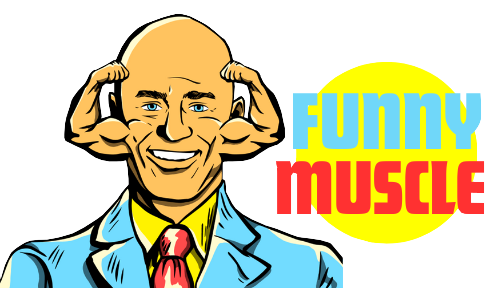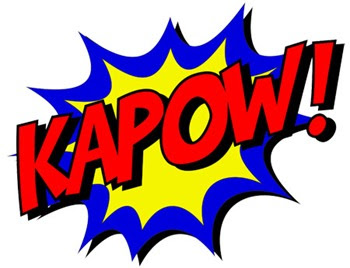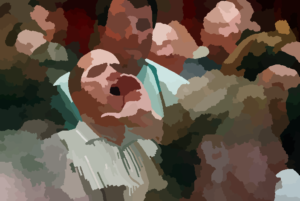Even if you’re not terribly funny, you can still effectively punch-up whatever you’ve written.
In the film and television industry, they pay joke writers a lot of money to make scripts funnier – it’s called ‘punching up the script’ – but any writer can do the same thing with their own work. All it takes is an understanding of some of the methods funny people use to heighten their material.
Even the funniest writers rarely find the true laughs in their first drafts.
It’s usually during the third and fourth drafts where they begin to punch it up. They do that by using different heightening techniques that comedians have been utilizing ever since the first cave dweller saw his buddy’s drawing of a Saber Tooth Tiger on a cave wall and added giant tiger balls.
So what do I mean by heightening?
Anything that raises the stakes, boosts the tension, amplifies the buildup, sharpens the specifics, strengthens the visuals, enhances the overall picture, or deepens the mental connection of the reader with the material.
Not only does heightening increase the chance for humor, but it also makes the writing way more compelling.
Here are the five heightening devices I’ll explore:
- Cut To:
- Funny Specifics
- Metaphors and similes
- Word and Sound effects
- Call Backs
If you’re a writer, you’re probably more or less familiar with those terms, but I’m going to go over each one as it applies to comedy. I’ll explain and then demonstrate how applying these heightening devices to your writing can unlock the hidden humor of your piece.
Remember – you don’t have to be funny at all to utilize these, just brave and willing.
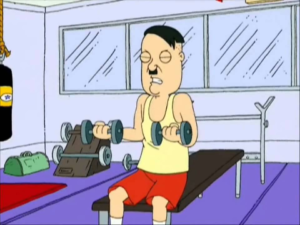
1. Cut To:
The ‘Cut to:’ is where you take the reader to an example of whatever it is that you’re talking about. It’s also called an “act out.”
Get extra laughs by creating a hypothetical scenario that better paints your picture.
The cartoon show “The Family Guy” uses this technique a lot so I’ll use examples from that show to help illustrate this move.
You can Cut Forward To a scene in the future to show what could happen based on the current situation.
Peter Griffin (with two friends): You hear that Quagmire? We’re on our way. We gotta celebrate, like girls in their twenties.
Cut forward to: (the three of them taking group photos in a booth, then displaying the “silly” pics)
You could also Cut Back To a scene in the past, which helps to explain how the current situation was created.
Lois Griffin: “You know most of the world’s problems stem from poor self-image.”
Cut back to: A skinny Adolf Hitler struggling with light weights at Das Gym.
or Cut Over To a scene that is happening simultaneously:
Peter Griffin (with family trapped on an icy mountain): “Lois, this is probably a terrible time to remember this, but I think I might have left the weed wacker on.”
Cut over to: (weed wacker on by itself tearing up their living room)
2. Funny Specifics
Which of these is funnier?
…and then I got hit with a vegetable.
…and then I got hit on the head with an eggplant.
…and then I got thumped in the face with a boiled eggplant.
They’re all humorous in a Three-Stooges sorta way, but the more specific imagery is just funnier:
- Getting hit by a vegetable is funny, but getting thumped by one is funnier because it creates a richer picture, including a sound (thump!)…
- Getting thumped is funny, but on the head is funnier, and getting thumped in the face by a veggie is funniest because it’s so specific it helps the reader best picture the thumpin’…
- A vegetable is funny, an eggplant is funnier, but a boiled eggplant tells its own story – I’m warm, mushy and ready to thump and splatter…

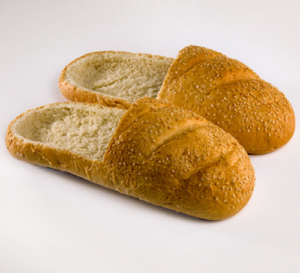
3. Metaphors and Similes
It’s always funnier when you can give the reader another similar image to picture, especially if it rings true, even more so if it connects in a surprising way and heightens the action.
Chris Rock is great at using these, like in his cruel large woman in high heels bit:
“Fat foot in a pump look like they baking bread in her shoe.”
Bill Hicks used metaphors and similes a lot, like in his bit about Van Gogh:
“Some guys take break-ups hard…he sent her his ear…that makes a dozen roses look like a booger.”
Even if a metaphor or simile isn’t downright hilarious, it can definitely help paint a funnier picture.
4. Word and Sound effects
If something in your writing makes a noise, spell it out for a laugh:
BAM! POP! Ka-POWIE! Psssssssss…
If something in your writing deserves a reaction, try writing it out:
UGH! Ooomph! Hoo boy!
Don’t overuse it though, or it gets old fast. Vrrrrrrm. Screeeech.
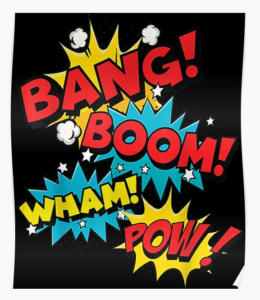

5. Call Backs
Call backs are simple – you just retell the same laugh-getting joke you told earlier and BAM! POP! Ka-POWIE! it gets another laugh!
Call backs are difficult – if you force them, or the original joke wasn’t humorous, they’re incredibly awkward and terribly unfunny. BAM! POP! Ka-POWIE! (crickets)
Call backs are wonderful – how cool is it to get two (or three) genuine laughs at the same joke? Why, that makes a dozen roses look like a booger! Ka-POWIE!
Get your FREE copy of The Business of Comedy!

Includes:
- How Comedians are 5-Tool Players
- How to Attract a Following
- How to Get Bookings
- How to Create Multiple Income Streams
- Manager vs Agent
- And More!
Plus you’ll also get…
- Top-10 Mistakes Unfunny People Make – a strong Funny Muscle avoids the list.
- 5 Surefire Ways to Make Your Next Speech Funnier – get laughs instead of yawns.
- 3 Humor Heightening Devices – pro comics use these to get bigger laughs.
Just ‘click‘ and enter a valid email address (then confirm it!) and you’ll get the free newsletter and your funny giveaways.
Then get ready to enjoy some laughs!


